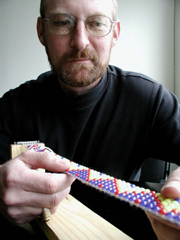
Jim Barta, Native Access
to Engineering Program (NAEP) visiting scholar
Photo by Andrew
Dobrowolskyj
|
by Frank Kuin
Jim Barta tries to make numbers
dance for First Nations children. He works on ways to make mathematics
relevant — even colourful — for young native students, who have
traditionally struggled with the field.
Barta, a soft-spoken visiting scholar with Concordia’s Native Access
to Engineering Program (NAEP), is passionate about ways to engage young
native students in mathematics — a science drenched in a Western
paradigm going back to the ancient Greeks.
He has been developing curricular activities that can help native children
learn basic math concepts in ways that incorporate their own cultural
background. Using beadwork patterns, for instance, he makes addition,
fractions and percentages come alive.
“We are trying to modify instructional approaches to incorporate
more of a focus on native culture, beliefs and values, and perceptional
paradigms,” said Barta, an associate professor in elementary education
at Utah State University who is spending a year at Concordia.
“When we say mathematics, we need to be clear that really the type
of mathematics we’re describing in our schools today is, for want
of a better label, Western mathematics,” he said.
Hence, native children face a double challenge when they encounter math.
“They’re having to learn the language of the Western world,
and then they’re having to learn the language of the math and science
that’s framed into that Western perspective.”
Barta hopes the culturally tailored approach will entice more native children
to become interested in the sciences. Traditionally, the dropout rate
among native students has been high. Barta described one native community
in Utah where only two or three out of every 10 finish high school and,
at best, one going on to university.
His aim of engaging native children in early science education complements
the mission of Concordia’s NAEP, which is to get native high-school
students interested in pursuing science studies, such as engineering.
He and NAEP founder Corinne Jetté agreed that you can’t begin
the process early enough.
“If we wait until high school to start encouraging our native students
to go to university and help them realize that math and science education
is really important, the pool is too small,” Barta said.
“My particular work is looking at young children, starting as soon
as they get into school and helping them realize that they do have mathematical
potential, that they’re capable of thinking about things and that
they’re needed.”
One way to help native children with math is “to make the numbers
dance,” Barta said, paraphrasing a concept he picked up at a conference
at Concordia. This approach seeks to make use of the fact that in native
cultures, world views tend to be more animated and spiritual — as
opposed to the more abstract perspective of the Western paradigm.
Barta has developed a program for Ute children in his home state of Utah,
called Honoring Ute Ways. It employs native-American concepts to teach
mathematics, while still fulfilling state curricular requirements. A colourful
example of a learning tool is a strip of native beadwork.
“It’s great, because there is probably no elementary math concept,
from kindergarten through sixth grade, that cannot be demonstrated using
beadwork as a model,” Barta said, listing simple counting, fractions,
percentages, and ratios as examples.
At the same time, a teacher can address the spiritual value of the beadwork,
talking, for instance about its symmetry. “There’s a beauty
to it,” Barta said. “It’s how these people express balance.
“If that’s where you begin with these young children, they start
to say, ‘Wow, I can understand these mathematics, because really
it’s describing who I am.’”
As part of his sabbatical year at Concordia, Barta has been visiting the
Kahnawake Indian reserve just south of Montreal and has interviewed teachers
there about math instruction. Eventually, he hopes to demonstrate that
“what worked for the Ute can work for the Mohawk.”
|
|
|



